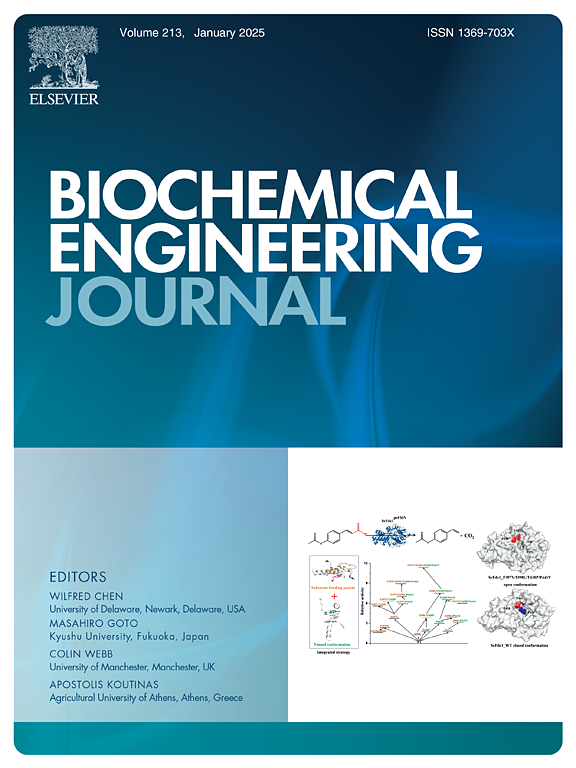利用毕赤酵母NCIM 3638提高脱油米糠糖回收用于木糖醇生产的工艺策略
IF 3.7
3区 生物学
Q2 BIOTECHNOLOGY & APPLIED MICROBIOLOGY
引用次数: 0
摘要
在有效利用木质纤维素生物质方面取得进展的同时,关于利用去油米糠(DRB)的科学数据明显缺乏,去油米糠是米糠油加工工业的农业工业残留物,用于生产具有商业价值的化学品。对DRB生物量进行生化分析,其总纤维素含量为39.09 % w/w。采用预处理和糖化相结合的策略,分别对白腐真菌和黑曲霉进行单菌和共培养,然后进行温和酸处理(1 % (v/v) H2SO4),以最大限度地提取DRB生物量中的糖。综合处理后,DRB的总糖产量为518.3 mg/g,最大脱木质素率为75.4 % (w/w),最大糖化率为78.5 % (w/w)。批发酵96 h时,脱毒DRB水解液发酵毕赤酵母NCIM 3638木糖醇产率最高,木糖浓度分别为0.48 g/g和23.56 g/L,经HPLC分析证实。所得木糖醇结晶率最高可达73.22 %。此外,采用非结构动力学模型对木糖醇生产的可行性进行了研究。这项工作验证了DRB生物质作为木糖醇生物生产的高效原料具有重要的前景。本文章由计算机程序翻译,如有差异,请以英文原文为准。
Process strategies for enhanced sugar recovery from de-oiled rice bran for xylitol production using Pichia fermentans NCIM 3638
Amidst advancements underway in exploiting lignocellulosic biomass efficiently, there is a noticeable dearth of scientific data concerning the utilization of de-oiled rice bran (DRB), an agro-industrial residue of the rice bran oil processing industry for the production of commercially valuable chemicals. The biochemical analysis of DRB biomass revealed that its holocellulosic content was 39.09 % w/w. A combined pretreatment and saccharification strategy was employed with mono and co-culture of two fungal species namely white rot fungi and Aspergillus niger sequentially followed by mild acid treatment (1 % (v/v) H2SO4) to extract maximum sugar from DRB biomass. This comprehensive treatment resulted in a total sugar yield of 518.3 mg/g of DRB and the maximum delignification and saccharification achieved were 75.4 % (w/w) and 78.5 % (w/w) respectively. At 96 h of batch fermentation, Pichia fermentans NCIM 3638 with detoxified DRB hydrolysate achieved a maximum xylitol yield and concentration of 0.48 g/g of xylose and 23.56 g/L and was confirmed through HPLC analysis. The produced xylitol was crystallized with maximum yield of 73.22 %. Further, an unstructured kinetic model was employed to study the feasibility of xylitol production. This work validates that DRB biomass possesses significant promise as a highly efficient feedstock for the bioproduction of xylitol.
求助全文
通过发布文献求助,成功后即可免费获取论文全文。
去求助
来源期刊

Biochemical Engineering Journal
工程技术-工程:化工
CiteScore
7.10
自引率
5.10%
发文量
380
审稿时长
34 days
期刊介绍:
The Biochemical Engineering Journal aims to promote progress in the crucial chemical engineering aspects of the development of biological processes associated with everything from raw materials preparation to product recovery relevant to industries as diverse as medical/healthcare, industrial biotechnology, and environmental biotechnology.
The Journal welcomes full length original research papers, short communications, and review papers* in the following research fields:
Biocatalysis (enzyme or microbial) and biotransformations, including immobilized biocatalyst preparation and kinetics
Biosensors and Biodevices including biofabrication and novel fuel cell development
Bioseparations including scale-up and protein refolding/renaturation
Environmental Bioengineering including bioconversion, bioremediation, and microbial fuel cells
Bioreactor Systems including characterization, optimization and scale-up
Bioresources and Biorefinery Engineering including biomass conversion, biofuels, bioenergy, and optimization
Industrial Biotechnology including specialty chemicals, platform chemicals and neutraceuticals
Biomaterials and Tissue Engineering including bioartificial organs, cell encapsulation, and controlled release
Cell Culture Engineering (plant, animal or insect cells) including viral vectors, monoclonal antibodies, recombinant proteins, vaccines, and secondary metabolites
Cell Therapies and Stem Cells including pluripotent, mesenchymal and hematopoietic stem cells; immunotherapies; tissue-specific differentiation; and cryopreservation
Metabolic Engineering, Systems and Synthetic Biology including OMICS, bioinformatics, in silico biology, and metabolic flux analysis
Protein Engineering including enzyme engineering and directed evolution.
 求助内容:
求助内容: 应助结果提醒方式:
应助结果提醒方式:


